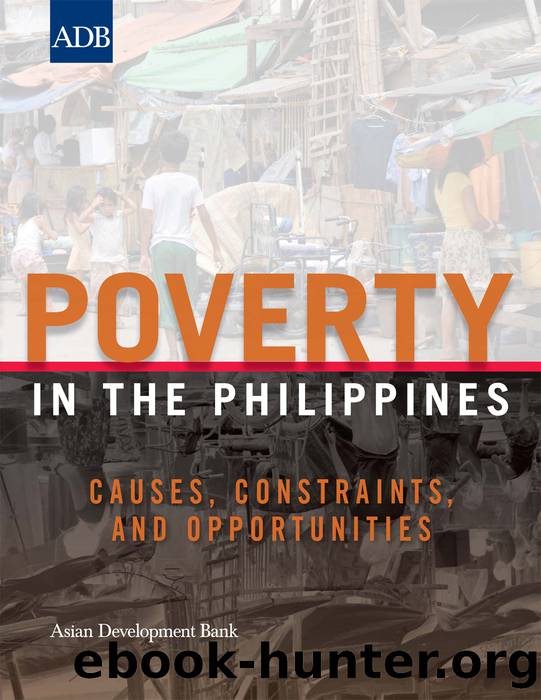Poverty in the Philippines by Asian Development Bank;

Author:Asian Development Bank;
Language: eng
Format: epub
Publisher: Asian Development Bank Institute
Published: 2009-08-15T00:00:00+00:00
KALAHIâCIDSS = KapitâBisig Laban sa Kahirapan Comprehensive and Integrated Delivery of Social Services Project, LGU = local government unit, NGO = nongovernment organization.
Source: Authorâs compilation.
⢠horizontal coordination among key agencies involved in poverty and social development; DOH, DepEd, DSWD, NAPC, and NEDA are the key coordinating agencies although they have overlapping functions;55
⢠vertical coordination within agencies (national to regional offices) and from national and regional to local government units;
⢠sector coordinationâthere are a number of agencies in one sector that also need to coordinate their actions (e.g., insurance, education); and
⢠multistakeholder coordinationâboth national and local agencies need to network with key stakeholders from civil society and the private sector.
Coordination consumes both time and resources, but is necessary in order to be able to craft well-designed and efficiently implemented programs. For example, many programs in the past were successful because of such coordination and complementation, which leads to optimized human and financial resources, smooth information flow, minimized waste and leakage in targeted programs, and avoidance of duplication of programs across national and local implementing agencies. However, insufficient resources constrain such coordinating mechanisms. For example, the NAPC convenes the different regional KALAHI convergence groups (RKCGs) but their funding is very limited.56 It will also need additional resources to coordinate and monitor the implementation of policies and programs decided by the RKCGs in their respective localities (i.e., provinces and municipalities). With improved technologies for information and communication, innovations in coordinating mechanisms can be tapped by government to improve the response to the poverty problem.
Crosscutting Concerns
Resource Allocation
Over the years, persistent budget deficits have led the government to substantially reduce spending on social services. Resources for poverty reduction and attaining the MDGs will not be sufficient in the years to come. Table 48 shows the decreasing government expenditures for both social services and infrastructure (as a percent of GDP) from 1998 to 2005. There were tight fiscal constraints during these years and a large share of revenues went to debt payments. Per capita expenditures, especially for education, also went down during the same period (Table 49). Lack of adequate financing partly explains the remaining challenges in social development.
Table 48: National Government Expenditures as a Percentage of Gross Domestic Product, 1990â2006
Download
This site does not store any files on its server. We only index and link to content provided by other sites. Please contact the content providers to delete copyright contents if any and email us, we'll remove relevant links or contents immediately.
Cecilia; Or, Memoirs of an Heiress — Volume 1 by Fanny Burney(31352)
Cecilia; Or, Memoirs of an Heiress — Volume 3 by Fanny Burney(30950)
Cecilia; Or, Memoirs of an Heiress — Volume 2 by Fanny Burney(30907)
The Great Music City by Andrea Baker(21621)
We're Going to Need More Wine by Gabrielle Union(18087)
Bombshells: Glamour Girls of a Lifetime by Sullivan Steve(13120)
Pimp by Iceberg Slim(12947)
All the Missing Girls by Megan Miranda(12776)
Fifty Shades Freed by E L James(12464)
Talking to Strangers by Malcolm Gladwell(11909)
Norse Mythology by Gaiman Neil(11902)
Crazy Rich Asians by Kevin Kwan(8373)
Mindhunter: Inside the FBI's Elite Serial Crime Unit by John E. Douglas & Mark Olshaker(7850)
The Lost Art of Listening by Michael P. Nichols(6485)
Enlightenment Now: The Case for Reason, Science, Humanism, and Progress by Steven Pinker(6414)
Bad Blood by John Carreyrou(5782)
The Four Agreements by Don Miguel Ruiz(5533)
Weapons of Math Destruction by Cathy O'Neil(5048)
We Need to Talk by Celeste Headlee(4881)
